When it comes to Mars exploration, NASA has more success than any other agency. This week, they’ll attempt to land another sophisticated rover on the Martian surface to continue the search for evidence of ancient life. The Mars Perseverance rover will land on Mars on Thursday, February 18th, and it’s bringing some very ambitious technologies with it.
Whatever your opinion of the USA is, you have to acknowledge NASA’s position as the world’s premier space exploration agency. That’s no slight against the ESA or other groups of humans around the world engaged in space exploration. But NASA’s on top.
They’re the only ones to land a rover on Mars, four of them in fact. They’re the only ones to land a person on the Moon, 12 of them in fact. And they’re the only ones to send a spacecraft out of the Solar System, two of them in fact.

The Perseverance rover builds on all of NASA’s other successes on Mars. At the same time, it’s upping the level of complexity. So now’s a good time to ask: Is the Perseverance rover the most ambitious space mission ever? More ambitious, even, than the Moon landings?
Though there’s no totally objective answer to that, we think the answer might be yes. Here’s why.
It Doesn’t Need Any Help Landing
Launching things into space on rockets is kind of ho-hum in this day and age. So much so that it’s shocking when a rocket blows up instead of succeeding. So Perseverance’s launch was “nothing special” if you know what we mean. It all went according to plan, and the cruise to Mars was also its typical uneventful affair.

Landing on Mars is where the gravy can get lumpy. The term “Mars curse” doesn’t exist for nothing. Many have tried to land on the red planet, but only a few have succeeded. Mostly NASA missions.
As technology progresses, landing spacecraft on Mars should be getting easier. In a way, it isn’t. Because the better the technology gets, the more we push it to do new things, including landing more accurately.
As time goes on, spacecraft sent to land on Mars are being asked to land in smaller and smaller areas. Rovers are amazing, but their travel speed is limited and so are their mission durations. Landing closer to the prime scientific targets is critical to mission success.
As the image below shows, Perseverance is being asked to land in a very small region, relative to its predecessors.
How will it do it?
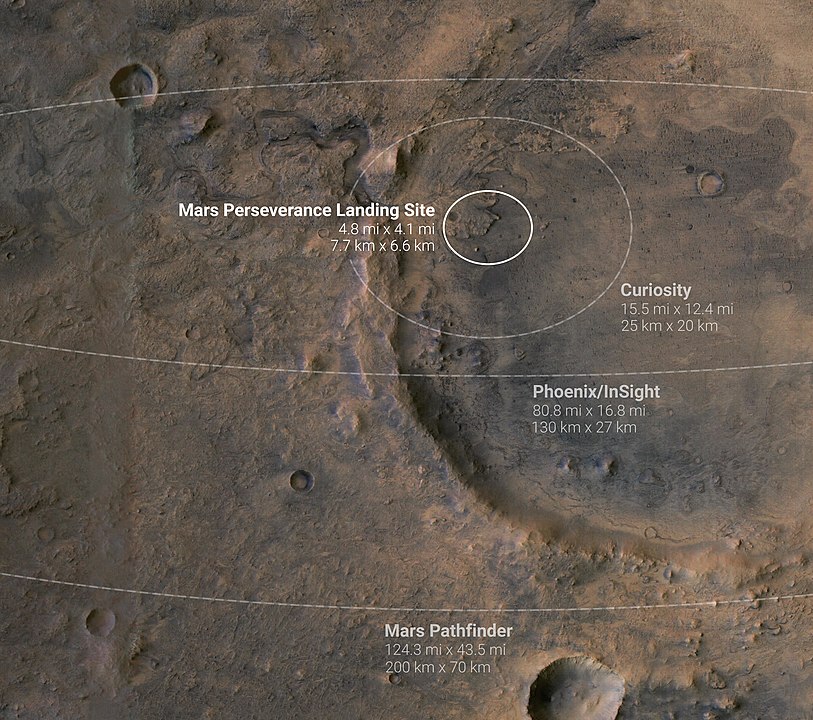
When Perseverance comes in for a landing on Mars, it’ll be on its own. It’s too far away from Earth for any real-time control of the landing procedure. Depending on both planets’ positions at a given time, it can take between four and 24 minutes for a signal to travel between them. When Perseverance lands on Mars, it’ll take about 11.5 minutes for a signal to travel one way. By the time we receive a signal that Perseverance has reached the top of Mars’ atmosphere, the lander will actually already have landed. So the landing will all happen automatically.
Perseverance will follow the same landing profile as other Mars landers. When it reaches the top of Mars’ atmosphere, it’ll be travelling at about 20,000 kph (12,500 mph). It’ll fire a de-orbit rocket burn, enter the atmosphere, deploy its parachute, and when it gets close enough to the surface, it’ll fire retrorockets to arrest its descent. But Perseverance has another trick up its sleeve.
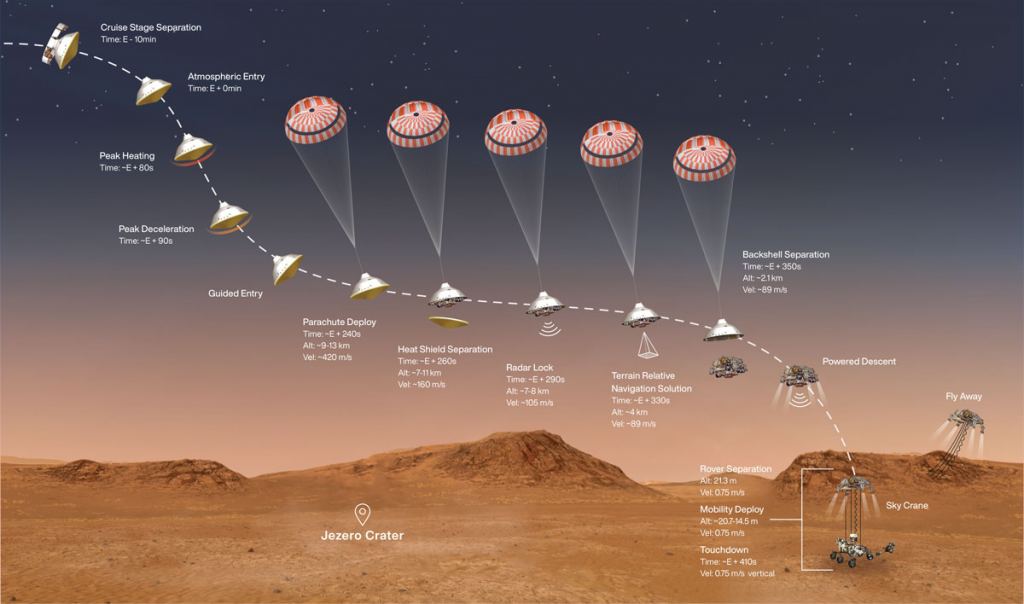
Perseverance features an automated hazard avoidance system called Terrain Relative Navigation (TRN.) NASA spent years developing this system, and though the OSIRIS-REx asteroid sampler used a similar method to touchdown safely on asteroid Bennu, there’s more at stake with Perseverance.
The TRN, or Landing Vision System (LVS), compares real-time images from its camera with an onboard “map” of the surface in Jezero Crater, Perseverance’s landing site. The map is created from high-definition orbital images of the crater area. If the rover is heading for a hazardous obstacle, it can fire its retro-rockets and avoid the hazard. OSIRIS-REx’s autonomous landing system worked the same way but had the capability to call off the touchdown and sampling procedure if it was in danger. It had enough fuel to do this a couple of times.
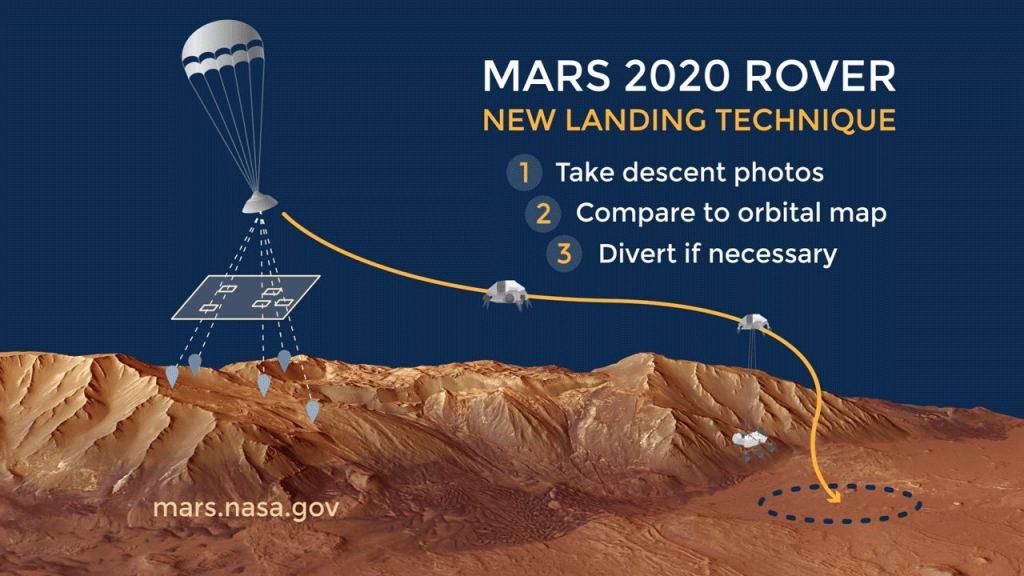
But Perseverance only gets one shot at landing, and its rocket fuel is limited. Once the descent and landing procedure is implemented, it’s going to reach the surface, no matter what. It can’t stop. It takes about 7 minutes for the rover to go from atmospheric entry to touchdown. If the landing system works as planned, the rover will safely reach the surface and begin its work in a prime location on the Martian surface.
Everything about sending a rover to another planet is ambitious. But Perseverance’s automated landing system is even more ambitious. If it goes according to plan, expect to see this system continually refined until rovers and landers can be placed on the surface with near-pinpoint accuracy. That only leads to better, more focused science. And that’s what it’s all about.
Perseverance Has Its Own Helicopter Wingman
When Perseverance reaches Mars, it won’t be alone. NASA is sending along a tiny helicopter named Ingenuity. Ingenuity is a technology demonstration mission, and a very ambitious one. Ingenuity won’t actually do any science, but it will provide important feedback on flight operations in the thin Martian atmosphere.
Ingenuity is tucked underneath Perseverance, on its belly. Its first task is just to survive the frigid nights on Mars, where temperatures can sink to -90 degrees Celsius (-130 F) at Jezero Crater. The little helicopter is built largely from off-the-shelf parts. So surviving the cold is its first challenge.
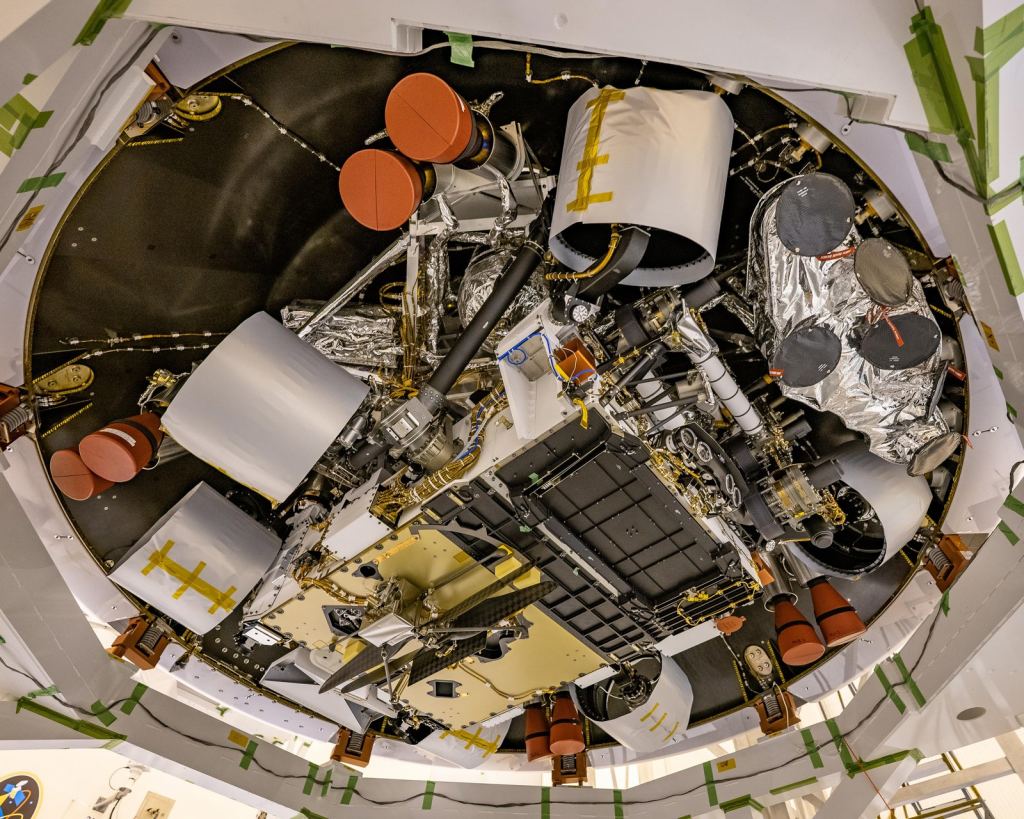
Then things get ambitious for Ingenuity. It’s the first craft sent to another planet to attempt powered, controlled flight. If it succeeds, the data it collects will be invaluable in developing rotary aircraft for future missions. Ingenuity only weighs about 1.8 kg (4 lbs) and has large rotors that rotate much more quickly than helicopter rotors here on Earth. That’s because the atmosphere is so thin that it’s difficult to create lift. But Mars’ gravity is weaker than Earth’s which will help the little helicopter succeed.
Its goal is to complete five short flights during a 30-day mission window. To complete its mission, Ingenuity has to contend with the distance between Earth and Mars the same way Perseverance does. So the tiny helicopter will receive some instructions from mission engineers before taking flight. But it will have to monitor its own temperature while flying to keep it from getting too cold. It also has to safely follow a flight path without real-time control.
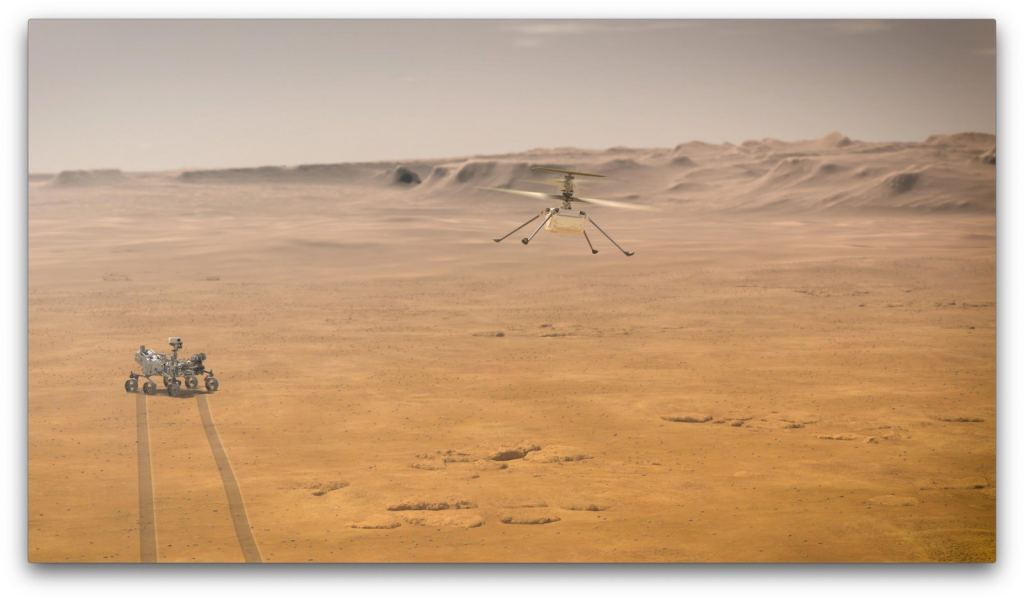
So our very first aircraft to attempt flight on another planet doesn’t even have the benefit of an experienced operator at the controls. Instead, it’ll rely on AI.
If that’s not ambitious, what is?
Collecting and Caching Samples for Eventual Return to Earth
Sample-return missions are growing in importance. Japan’s Hayabusa2 spacecraft recently collected samples from asteroid Ryugu and returned them to Earth. And NASA’s OSIRIS-REx just successfully collected samples from asteroid Bennu. Those samples will be returned to Earth in September 2023.
But those are asteroid samples. And while those missions were complex, sampling an asteroid isn’t as difficult as collecting a sample from an actual planet. An asteroid’s relatively weak gravity makes them easier to maneuver around.
Perseverance won’t be returning the samples to Earth. That’s way too much complexity for one mission. But the rover does have some sampling ambitions.
Perseverance is equipped with a drill, of course, and it can collect sample cores from rocks and soil. When scientists identify important rocks and soils that they want to study more closely, Perseverance can collect them and place them in sealed tubes. There are 43 sample tubes altogether.
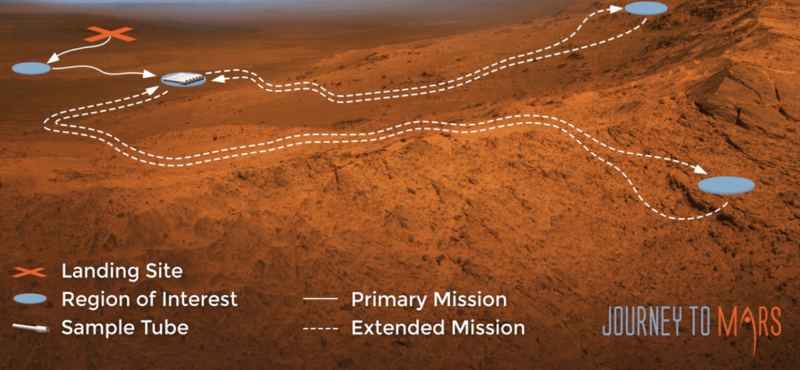
Perseverance has a separate robotic arm just to manage the samples and store them in tubes. The sample tubes will be placed in caches on the surface, and the locations of these samples will be catalogued. Orbiter images will identify the sample locations to within one meter (3 ft) and the rover itself will increase that accuracy to within one centimeter.
Perseverance also has what are called “witness tubes.” It has five of these tubes, and they’re used to collect ambient samples of the atmosphere near sample-collection and drilling sites. They’re already full of materials that can absorb molecular and particulate contaminants. When the samples are eventually returned to Earth, they can be compared to the witness samples to see if any contaminants from Earth were present during the sampling.
But here’s where it gets really ambitious: returning the samples to Earth.
There’s a plan brewing to get them back to labs on Earth. A lander would be sent to Mars near the cache locations, and a tiny rover would be sent out to collect them according to Perseverance’s detailed map. The small rover would then return them to the lander.

From there, they would be launched into Mars orbit by a rocket that was brought to the surface with the lander. Then a separate craft orbiting Mars called the Earth Return Orbiter would collect the samples and bring them back to Earth. The ESA aims to play a big role in the sample return.
Though the sample return isn’t part of Perseverance’s mission, strictly speaking, it’s still extremely ambitious. And for those samples to be valuable, Perseverance has to do its job with utmost diligence.
Artificially Intelligent Space Laser
A critical part of a rover’s job is to study the chemical makeup of its surroundings. The makeup of Martian rock and regolith is of prime importance in Perseverance’s search for evidence of past life and habitability. Spectroscopy plays a huge role in this.
Spectroscopy involves watching closely as light passes through a gas. The patterns in the wavelengths of light betray the presence of certain elements and compounds. But the problem is that rock is solid.
So Perseverance is equipped with a multi-functional instrument called SuperCam. SuperCam contains three separate spectrometers. One of them is called LIBS, or Laser-Induced Breakdown Spectroscopy.
The laser in Perseverance’s LIBS has about 7 meters (20 ft) range, and it can be used to blast suitable targets with enough energy to heat a target rock to 10,000 degrees Celsius (18,000 F) and create a puff of plasma. Its spectrometers can then read the light as it passes through the plasma to determine the rock’s makeup.
If that’s not ambitious enough, the laser can do its own blasting without human input. It has an AI that can identify desirable targets while the rover is en-route. Then it can fire the laser and take spectroscopic readings, all without being told to do so. MSL Curiosity had a similar instrument with similar AI, but Perseverance’s is much-improved and has greater pinpoint accuracy.
In our books, an artificially-intelligent space laser spectrometer is ambitious—it kind of sneaks in behind all the other ambitious aspects of the mission, like the helicopter. But make no mistake: a laser and spectrometer that can choose their own targets without human input are definitely ambitious.
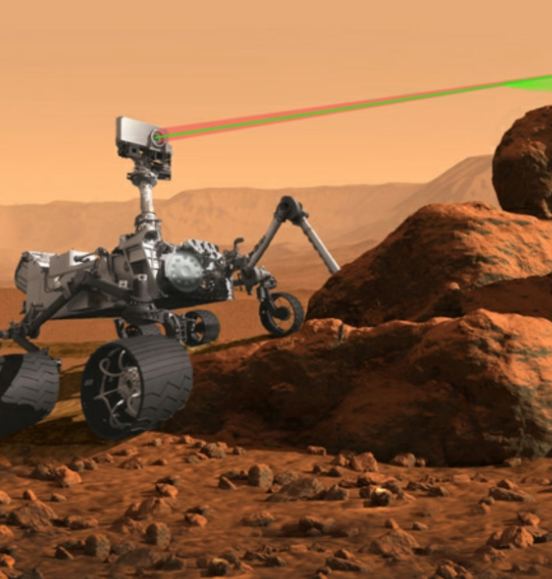
In the final analysis, it’s impossible to define the most ambitious space mission. For instance, it’s difficult to compare the Perseverance rover with the historic Moon landings. And really, there’s no need to. Humans just like to rank things.
But any way you look at it, NASA’s Perseverance rover mission is extremely ambitious. It could potentially deliver some knockout evidence when it comes to Mars’ ancient habitability. There are also many ways that things could go sideways, which is part of ambitious missions like this.
Whether we judge it as the most ambitious or not doesn’t really matter in the end. But all that ambition really defines the mission.
And if NASA can pull it off, they’ll have cemented their position as Earth’s most ambitious—and accomplished—space agency.
More:
- NASA: Mars Perseverance Rover
- Universe Today: NASA’s Perseverance Rover is Going to Jezero Crater, Which is Looking Better and Better as a Place to Search for Evidence of Past Life on Mars
- Universe Today: This is What Perseverance’s Landing Site Looked Like Billions of Years Ago. See Why it’s Such a Compelling Target?


Well if there are Martians, the rover firing its AI Space laser might be perceived as less than friendly 😉
I think it’s worth noting that for all previous Mars landings, all or almost all of the landing ellipse needed to be safe terrain for a landing. The Terrain Relative Navigation used on Perseverance allowed it to land at a site where – from the imagery I’ve seen – there were more dangerous spots than safe spots. Jezero would not have been an option without TRN.